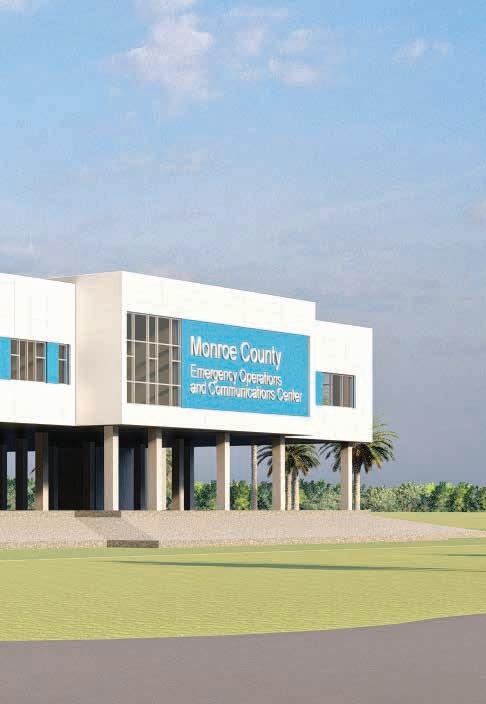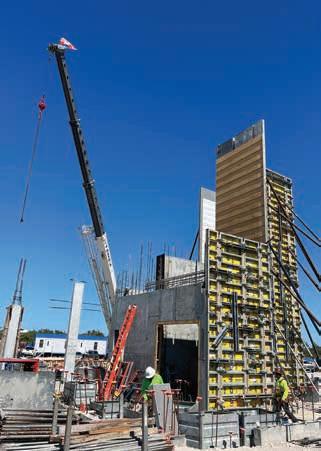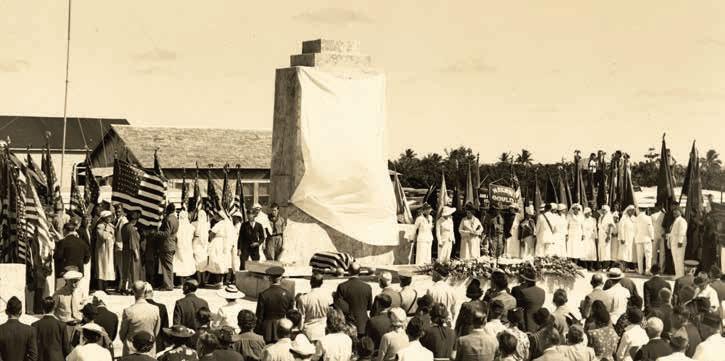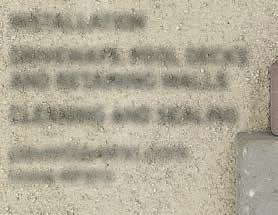
6 minute read
EARNING THE GRADE WHAT EXACTLY MAKES A ‘HURRICANE RATING,’ ANYWAY?
To say the phrase “hurricane rated” carries weight in the Florida Keys is the understatement of the century. Those two words can at once signify safety, a resilient community, and more often than not, a whopping price tag.
But for those of us – like this author – who know very little about construction, the phrase is somewhat a mystery. What exactly does a hurricane rating entail? What design features justify a particular classification? And just how tough are these buildings?
To answer some of these questions, the Keys Weekly sat down with Marshall Quarles, senior project manager for Ajax Building Company, the firm tasked with completing Monroe County’s upcoming Emergency Operations Center in Marathon. Though each building’s construction differs, Quarles took us through a few of the design elements that will enable the center to take on a 500-year storm with 220 mph winds.
Layers Upon Layers Of Building Codes
When talking about hurricane construction, the Florida building code is just the beginning. In addition, FEMA, the Division of Emergency Management and the Department of Transportation have their own sets of guidelines. And when it comes to building shelters, the ICC 500 governs everything from the design and construction to installation and inspection of both residential shelters –intended for 16 people or less – and communal gathering spaces.
Buildings are assigned a letter from A to D, as well as a number from 1 to 4, indicating both their risk and exposure during a storm. As a near-water shelter with direct ocean views tasked with housing critical emergency management personnel in a highly hurricane-prone area, Monroe County’s new EOC is a D4 building.
Elevators And Staircases Are The Anchors
In order to resist lateral forces that could contort the building’s basic shape during high winds, the walls of the building’s four- or six-sided elevator shafts and stairwells are each poured in a single seamless process.
“You have those cores that ‘lock in’ the building,” Quarles explained. “That way, there can’t be any movement to torque the building in any way.”
Three-by-two-foot concrete beams tie these anchor points together and serve as supports for the floors and other walls. While typical rebar used in concrete walls and beams is “ 5/8 or ¾” in diameter, several bars used in the new shelter’s beams and critical anchor points measure 1-1/8” to 1- 3/8”.
IT’S ALL IN THE MIX
The compressive strength of concrete used in most homes usually ranges between 2,500 and 3,000 pounds per square inch (psi). In contrast, aided by its higher cement ratio, the concrete used in the EOC – even on the roof – is rated at 5,000 psi. For comparison, that’s closer to the strength of concrete poured on high-stress areas of airport runways.
“5,000 is like, I’m going to run a concrete truck or garbage truck over this and I don’t want it to crack, and our whole building is built that way,” Quarles said.
A higher cement ratio in the concrete helps with waterproofing, and on top of this, many of the foundations and retaining walls have a product called Xypex in the mix. Designed to further aid in waterproofing, the product has a crystalline structure that fills the voids when small-scale cracks occur.
Hit It With Your Best Shot
To meet the windborne debris missile criteria for a hurricane shelter, the building’s glass and openings must be able to withstand impacts from a nine-pound two-by-four propelled at 110 mph.
“That’s basically what a lot of doors, windows, gates and things like that go through that want the designation to be hurricane rated,” Quarles said. “They get tested in a lab where they literally shoot two-by-fours at products to verify they’re strong enough.”
Glass used in the EOC is more than two inches thick, with multiple layers providing strength. And though many think of “hurricanerated” fixtures, Quarles said a good deal of tests and ratings are actually geared towards tornadoes – a devastating accessory of hurricanes – that create higher loads at specific points during extreme events.
Lock It Up
Even little elements can make all the difference when it comes to preventing a small breach that can evolve into a larger problem during a storm. In addition to lock-level latches on doors, additional supports extend to latch into the top and bottom of a door frame, for a total of three per door. And when it comes to double doors, having a central post to provide an all-around frame of support for each swinging door – as opposed to just a piece of felt or weather stripping where the two doors meet – is a big deal.
(DON’T) RAISE THE ROOF
The roof of the new center utilizes two membranes, with insulation between them, over the thick concrete deck. Steel grating protects HVAC and other external mechanical equipment. When all is said and done, the roof can withstand more than 570 pounds per square foot of upward suction pressure, generated when winds up to 220 mph whip across its surface.

By Brad Bertelli
1935 Labor Day Hurricane reshaped the Keys
When a hurricane threatens to strike Key West, people are attracted to the grounds of The Basilica of Saint Mary Star of the Sea, where they stop to pray at what is sometimes called the Hurricane Grotto. Built by Sister Louis Gabriel, who arrived at the Key West church on Aug. 25, 1897, it is officially called Our Lady of Lourdes Grotto.
While there, she survived three hurricanes. After witnessing the storms’ destruction, she built the grotto in honor of the Blessed Mother Mary, hoping it would ward off future storms. Sister Gabriel built the structure from rocks found on the island, and when it was dedicated in 1922, she said that as long as the Grotto stood, Key West would be protected. To this day, when a storm threatens, the Grotto becomes a center for prayers of protection.
One of the hurricanes that did not strike Key West was the 1935 Labor Day Hurricane. The Category 5 storm that redefined the Florida Keys in general and the Upper Keys, in particular, remains the strongest hurricane to ever strike North America. The deadly hurricane was responsible for taking hundreds of lives, essentially wiped Islamorada off the map, and ended the run of Henry Flagler’s Over-Sea Railroad.
In response to the storm, the Florida Keys Memorial was erected on Upper Matecumbe Key to honor those who lost their lives in the devastating event. The iconic Islamorada landmark resulted from President Franklin D. Roosevelt’s Works Progress Administration. The Miami-based Harvey W. Seeds Post of the American Legion also helped raise money to build what is often referred to as the Hurricane Monument.
The monument’s obelisk and crypt were built out of keystone, a decorative limestone rock made by chiseling slabs of limestone substrate from quarries operating at sites contained within what is now the Windley Key Fossil Reef Geological State Park. The 18foot obelisk represents the approximate height of the tidal surge that swept across the area at about 8:25 p.m. on that fateful Labor Day.
Artist John Klinkenberg inscribed the bronze plaque attached to it: “Dedicated To The Memory Of The Civilians And The War Veterans Whose Lives Were Lost In The Hurricane Of September Second 1935.”
At the foot of the obelisk is a 22-foot-long crypt, decorated with a mosaic tile design created by Adela Gisbet. Her ceramic work represents the span of islands from Key Largo to Key Vaca, the area directly impacted by the hurricane. The ashes of an undetermined number of hurricane victims have been interred inside the crypt. The number is hard to determine because two years after the pine boxes containing the victims were stacked, burned and scattered in more than 20 cremation sites in the Islamorada area, the dust and dirt were recovered and placed within the crypt.
The 18-foot obelisk representsthe approximateheight ofthetidalsurgethat sweptacrossthearea atabout8:25p.m. on that fateful Labor Day.BRADBERTELLI/ Contributed
The monument was unveiled on Nov. 14, 1937. Faye Marie Parker, 9 years old and one of the hurricane’s survivors, was invited to pull the cord on the sheet covering the obelisk. She was helped by two Boy Scouts. As many as 4,000 people attended the event, including state dignitaries and mayors from Key West to Fort Lauderdale. At 1 p.m., Chaplain E.R. Reedy of the Henry Seeds Post, American Legion, began the service. A child-sized casket containing the remains of Herman Saulter, a World War I veteran from Philadelphia, was interred within the crypt. His remains were identified through discharge papers discovered tucked inside his coat pocket.
If you stop by this sobering roadside attraction, interpretive panels behind the monument reveal more of the devastation left behind by the 1935 Labor Day Hurricane.





By Mandy Miles





